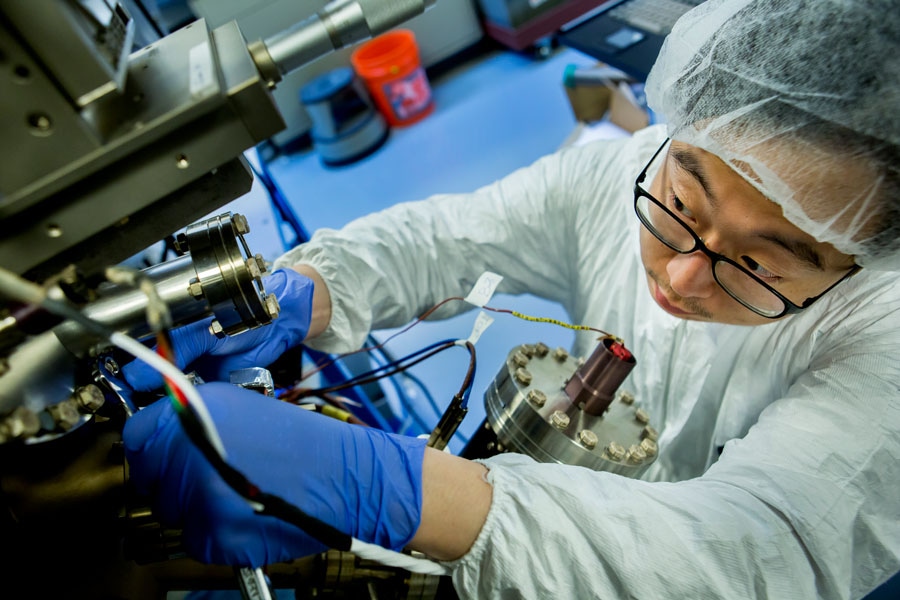Jun 16 2017
Researchers from the University of Michigan have created a new semiconductor alloy that can capture the near-infrared light located on the leading edge of the visible light spectrum. This could be an important step for the advancement of a new generation of solar cells called "concentrator photovoltaics."
 Sunyeol Jun, MSE PhD Student, calibrates the molecular beam epitaxy apparatus in the Gerstacker Building on August 3rd, 2015. Photo Credit: Joseph Xu
Sunyeol Jun, MSE PhD Student, calibrates the molecular beam epitaxy apparatus in the Gerstacker Building on August 3rd, 2015. Photo Credit: Joseph Xu
Easier to produce and at least 25 % less expensive than earlier formulations, it is considered to be the most cost-effective material in the world. It can capture near-infrared light, and is compatible with the gallium arsenide semiconductors repeatedly used in concentrator photovoltaics.
Concentrator photovoltaics collect and focus sunlight onto small, high-efficiency solar cells made of germanium or gallium arsenide semiconductors. They are on track to realize efficiency rates of more than 50 %, while conventional flat-panel silicon solar cells just reach the mid-20s.
Flat-panel silicon is basically maxed out in terms of efficiency. The cost of silicon isn't going down and efficiency isn't going up. Concentrator photovoltaics could power the next generation.
Rachel Goldman, U-M professor of Materials Science and Engineering, and Physics
A wide range of concentrator photovoltaics are available today. They are composed of three different semiconductor alloys layered together. Sprayed onto a semiconductor wafer in a method called molecular-beam epitaxy—similar to spray painting with individual elements—each layer measures only a few microns in thickness. The layers capture different areas of the solar spectrum; light that passes through one layer is captured by the next.
However, near-infrared light slips through these cells without being captured. For years, Researchers have been working toward an obscure "fourth layer" alloy that could be sandwiched into cells to trap this light. It is a challenging task. The alloy must be economical, durable, stable and sensitive to infrared light, with an atomic structure that matches the solar cell’s other three layers.
To achieve all those variables is not easy, and until now, Researchers have been stuck with excessively expensive formulas that use five elements or more.
To discover a simpler mix, Goldman's team came up with a novel approach for keeping tabs on the multiple variables in the process. They combined on-the-ground measurement techniques including X-ray diffraction done at U-M and ion beam analysis done at Los Alamos National Laboratory with customized computer modeling.
Using this technique, they found out that a marginally different type of arsenic molecule would pair better with the bismuth. They were able to alter the quantity of bismuth and nitrogen in the mix, enabling them to eliminate an extra manufacturing step that earlier formulas required. And they found precisely the accurate temperature that would enable the elements to blend smoothly and adhere to the substrate securely.
'Magic' is not a word we use often as Materials Scientists. But that's what it felt like when we finally got it right.
Rachel Goldman, U-M professor of Materials Science and Engineering, and Physics
The advance comes soon after another innovation from Goldman's lab that streamlines the "doping" process used to tune the electrical properties of the chemical layers in gallium arsenide semiconductors. During doping, Manufacturers apply a blend of chemicals called "designer impurities" to alter how semiconductors conduct electricity and give them positive and negative polarity akin to a battery’s electrodes. The doping agents typically used for gallium arsenide semiconductors are beryllium on the positive side and silicon on the negative side.
The beryllium is a problem—it is lethal and it costs roughly 10 times more than silicon dopants. Beryllium is also sensitive to heat, which hinders flexibility during the manufacturing process. But the U-M team found out that by minimizing the quantity of arsenic below levels that were earlier considered satisfactory, they can "flip" the polarity of silicon dopants, allowing them to use the cheaper, safer element for both the negative and positive sides.
"Being able to change the polarity of the carrier is kind of like atomic 'ambidexterity,'" said Richard Field, a former U-M doctoral student who worked on the project. "Just like people with naturally born ambidexterity, it's fairly uncommon to find atomic impurities with this ability."
Together, the enhanced doping process and the new alloy could make the semiconductors used in concentrator photovoltaics as much as 30 % cheaper to manufacture, a major step toward making the high-efficiency cells feasible for mass electricity generation.
Essentially, this enables us to make these semiconductors with fewer atomic spray cans, and each can is significantly less expensive. In the manufacturing world, that kind of simplification is very significant. These new alloys and dopants are also more stable, which gives makers more flexibility as the semiconductors move through the manufacturing process.
Rachel Goldman, U-M professor of Materials Science and Engineering, and Physics
The new alloy is described in a paper titled "Bi-enhanced N incorporation in GaAsNBi alloys," published on June 15th in Applied Physics Letters. The National Science Foundation and the U.S. Department of Energy Office of Science Graduate Student Research supported the research.
The doping advances are described in a paper titled "Influence of Surface Reconstruction on Dopant Incorporation and Transport Properties of GaAs(Bi) Alloys". It was published in the December 26th, 2016, issue of Applied Physics Letters. The research was supported by the National Science Foundation.